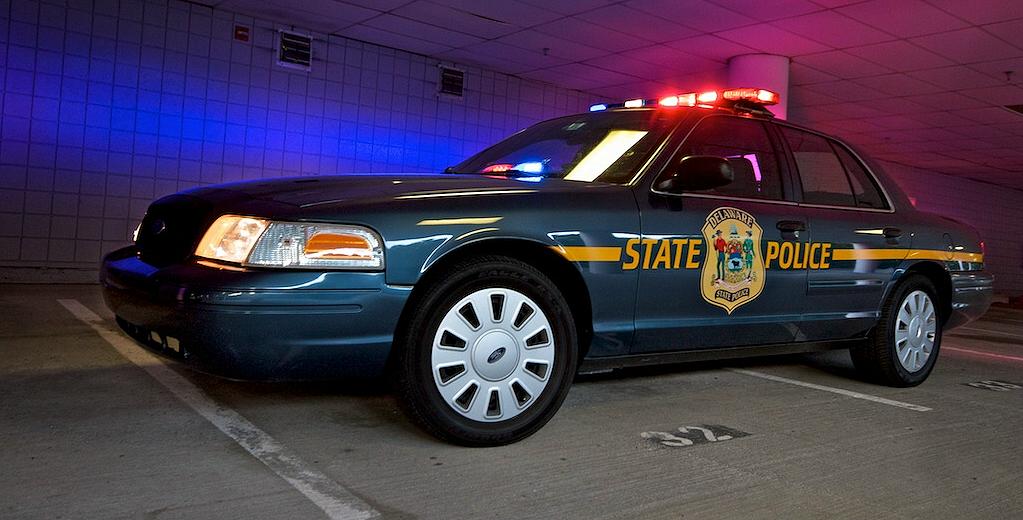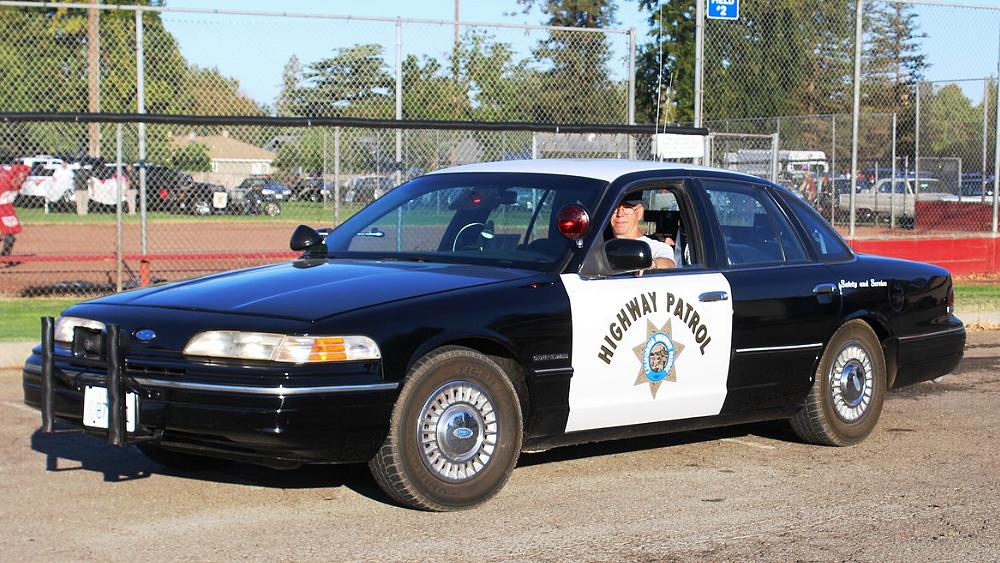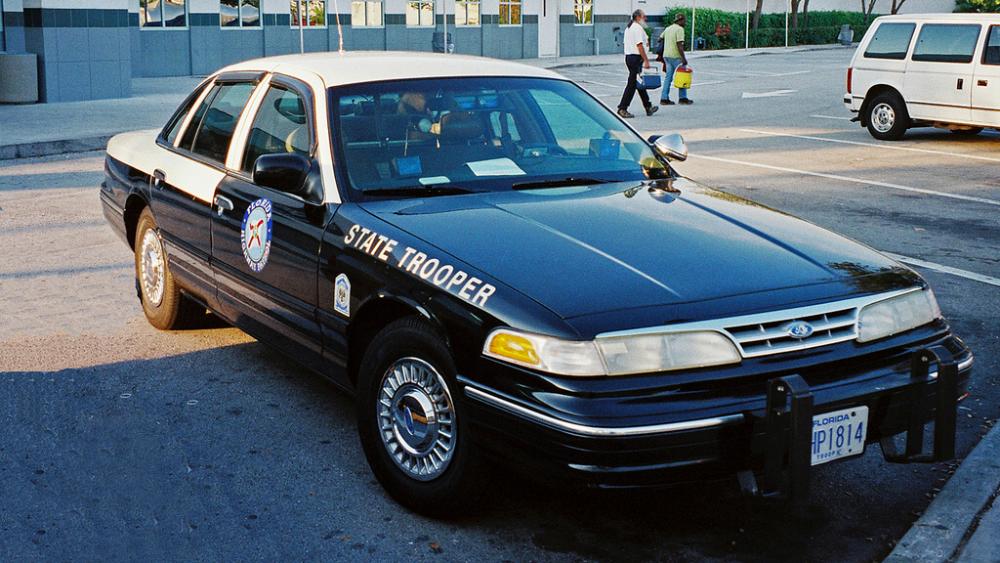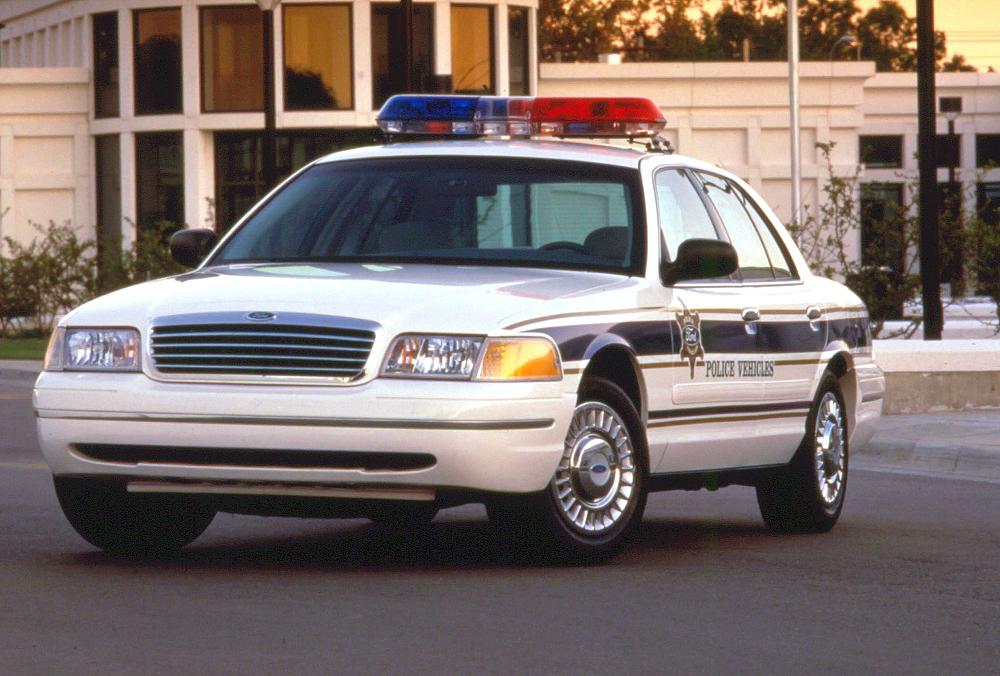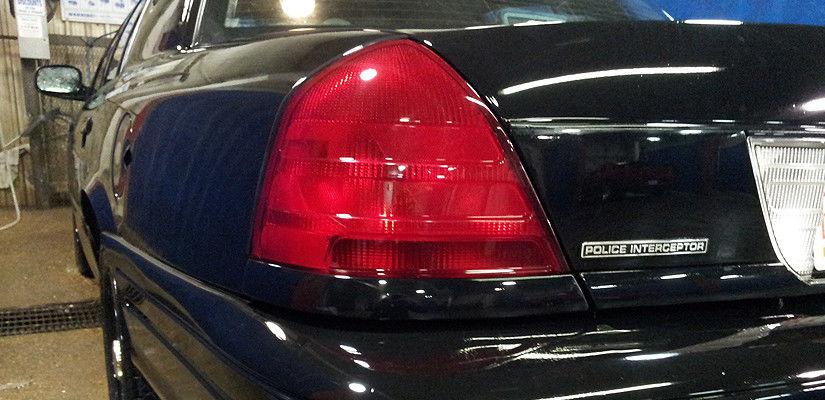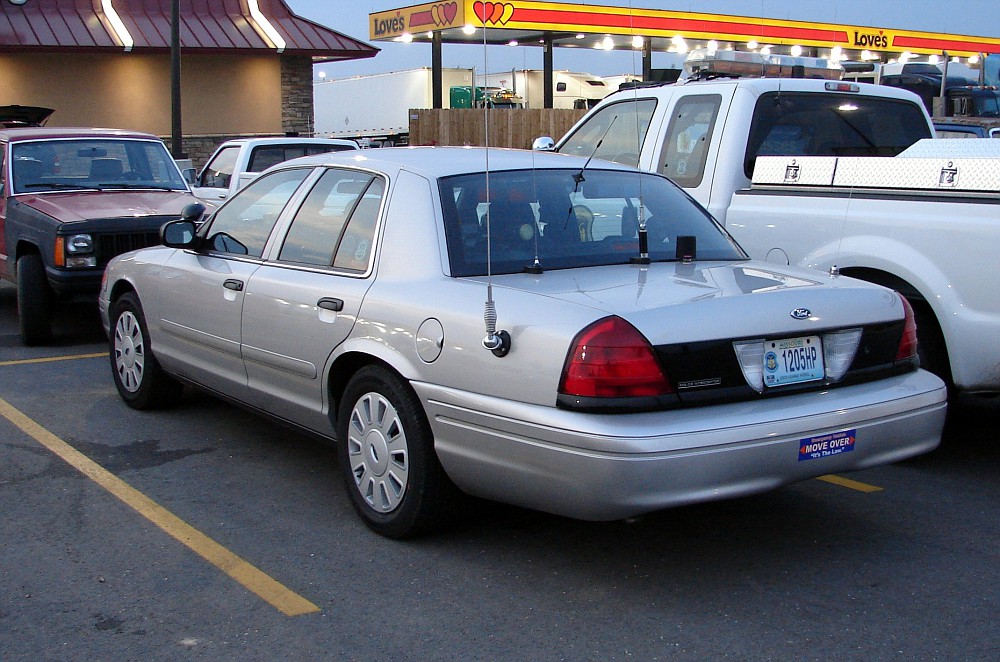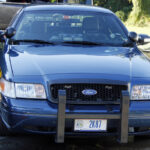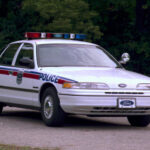the 1992 Crown Victoria featured a major exterior redesign while retaining the previous-generation chassis. Ford reduced the coefficient of drag of the exterior from 0.42 to 0.34 (nearly matching the 0.32 of the Ford Taurus) to enhance aerodynamics and fuel efficiency, giving the Crown Victoria its sleek, wedge-shaped design that would come to be known as the “Aero” look. Prior to 1992 the Crown Victoria was actually the LTD Crown Victoria, but the LTD name was dropped for 1992.
(1992 Ford Crown Victoria – California Highway Patrol)
The 1979-1991 full-size LTDs and LTD Crown Victorias used the “P72” production code designation for both fleet and taxi and police models, with the model itself being internally classified as S (similar to LX). From 1992 to 1997, the police car models of the Crown Victoria (both base and LX trims) were officially known as the Crown Victoria P71.
(1993 Ford Crown Victoria – Iowa State Patrol)
The 1993 model was given a chrome front grille and a reflector strip between the taillights. Another minor restyle followed suit in 1995, with a new grille and taillights. To accommodate the design of the 1995’s new taillights, the rear license plate was moved from the bumper to the trunk’s lid.
(1995 Ford Crown Victoria – Florida Highway Patrol)
For 1996, the Crown Victoria badge on the front fenders was removed and the cars received a new steering wheel. 1997 models have a lighter blue interior color vs prior years.
(1998 Ford Crown Victoria)
For the 1998 model year, Ford restyled the Crown Victoria, eliminating the 1992-1997 “aero” look; adopting the more conservative styling of the Mercury Grand Marquis. Both cars included restyled front and rear end components. The 1998 police package P71 had a chrome grille, chrome door handle trim, chrome bumper strips, and a chrome-trimmed flat black rear fascia with the “Crown Victoria” badge. At this time, the car was still known as the “Crown Victoria P71”.
Police Interceptor:
(Police Interceptor Emblem)
In 1999, Ford introduced the “Crown Victoria Police Interceptor” name, with a badge on the trunk lid replacing the 1998 “Crown Victoria” badge. A chrome-trimmed gloss black rear fascia, black door handle trim, black bumper strips, and a gloss black slatted grille were also introduced at this time. Finally, the new “Street Appearance Package”, intended to make the Police Interceptor look like a Standard (P73) model, including chrome trimming and badging, was introduced.
Midway through 1999, the taillights were also changed. 1998 and early 1999 models had a separate amber turn signal along the bottom edge of each taillight housing. Starting in mid-1999, the extra bulbs were eliminated and the turn signals returned to the combination of stop/turn setup with red lenses found in many North American cars. Although the lenses changed, the housings did not; they still had the chambers for the separate turn signals that early models had. These chambers were now empty, leaving a perfect place to install in police cars strobe tubes that would not affect brake or turn signal visibility. Non-Police Interceptors and Police Interceptors equipped with the “Street Appearance Package” retained the amber turn signal until 2004 (when all CVs changed to all-red taillights).
For 2000, the rear fascia and tail-lights lost the chrome trim, and the gloss black grille was dropped in favor of a flat black slatted grille. Further alterations were made in 2001, including removal of all trim on the plastic bumper pieces and a new honeycomb-style grille, replacing the slat-style grille as is found on previous standard Crown Victorias and CVPIs. Power adjustable pedals also became an option starting in the 2001 model year, as height diversity among officers joining police departments increased. Ford also relocated the rear window defrost switch from the left side of the dash to the direct left of the HVAC controls. The Ford logo on the steering wheel was blue instead of the interior’s color.
The year 2003 brought considerable changes. Interior door panels and seats were freshened, with side-impact airbags becoming an option. The 2001–2004 CVPIs all look the same on the exterior; the way for one to tell the 2003–2011 cars apart from the 2001 and 2002 models is by examining the wheels. The frame, steering, suspension, and brakes were all significantly redesigned for the 2003 model year. Because of the new underpinnings, the wheels for the newer cars have a much higher offset. They look almost flat, compared to the concave wheels on the older model years. Along with a new wheel design, new hubcaps were introduced. Lastly, the 2003 model year was the last model in the second generation of CVPIs to feature a cassette player in the stock head unit. However, the 2011 model did include an optional player.
The 2004-2011 Police Interceptor is rated for 250 hp mostly due to the addition of a new better flowing air intake system. This system includes a new airbox that is similar to the Mercury Marauder airbox (raised airbox lid, deeper bottom), with an integrated 80 mm (3.1 in) mass airflow (MAF) sensor that is part of the airbox lid (but can be serviced individually). This allows for much more precise flow calibration and reduces the chances of air leakage. The P71 zip tube (the flexible rubber hose between the throttle body and MAF outlet) is also used to reduce NVH (noise, vibration, and harshness) as well as transfer air from the airbox to the throttle body with minimal flow resistance. From 2005 on, the throttle body is no longer manually operated via cable but an electronic Drive-By-Wire (DBW) set up.
2005 models received a new steering wheel and the AM/FM radio antenna was removed from the rear window and moved to the rear quarter panel (only for the 2005 MY).
Standard on the 2006 is a redesigned instrument cluster, which now sports an analog speedometer, tachometer, digital odometer with hour meter and trip meter features, and cross-compatibility with the civilian version’s various features (these are normally locked out, but can be accessed through wiring modification). Kevlar-lined front doors, which might be useful as protective barriers during gunfights, are optional on the Crown Victoria Police Interceptors for the 2006 Model Year. Also introduced in 2006, for P70/P72 Commercial Heavy Duty models and P71 Police Interceptor models is a 17″ steel wheel, replacing the previous 16″ wheels, plus new flat gray wheel covers rather than chromed wheel covers as in previous years.
For 2008, the Crown Victoria is restricted to fleet-only sales, and all Panther-platform cars are now flex-fuel cars. The CVPI receives some new options, such as the ability to have keyless entry.
(Missouri Highway Patrol Unmarked Ford Crown Victoria)
For the 2009 model year, the CVPI now has power pedals as standard equipment. Standard equipment across the entire Panther line is side impact airbags and new federally mandated recessed window switches. The CVPI also received upgraded brakes for 2009, although specifics about them are not available. The confirmation flash that occurs when the doors are locked is now automatically disabled when the Courtesy Lamp Disable option is ordered. The confirmation flash was considered to be a safety issue because the lights would flash when officers exited the vehicle and locked the doors, potentially giving their presence away at night. The car gets new styled door moldings and also, Ford placed a “Flex Fuel” badge in the lower right corner of the rear fascia (2009–2011) even though they were flex fuel capable since 2008. The Street Appearance Package also gets the same new door moldings as found on the civilian fleet only Crown Victoria LX as well as blacked rear fascia like the normal Police Interceptor & Crown Victoria LX. In 2010, the VIN code “P71” was replaced with “P7B”.
The 2011 model year Ford CVPI (P70, P72 taxi/commercial and regular civilian model the P74) received updated larger front headrests to comply with new front crash rating standards.
Difference Between Police & Civilian Models:
Police Models Have:
- An external oil-to-engine-coolant oil cooler
- More aggressive transmission tune
- 3.27:1 rear axle (Axle code Z5) electronically limited to 129 mph
- 3.27:1 rear axle (Axle Code X5) with Trac Loc electronically limited to 129 mph (optional)
- 3.55:1rear axle (Axle code C6) with Trac Loc electronically limited 119 mph (optional)
- 1999-2001 Police Interceptors equipped with the 3.55:1 rear axle ratio were limited to approximately 124 mph.
- Civilian models have 2.73 rear axle ratio with a speed limitation of 110 mph
- Ford’s “severe duty” shock absorbers
- T-409 stainless steel dual exhaust systems without resonators
- Higher-rate coil springs, approximately 0.8 inches of additional ground clearance
- 2004-2011 models have a 200 A alternator and a 78 A h battery
- 140 MPH calibrated speedometer
How To Identify:
Don’t assume that because it has a Police Interceptor emblem that it’s a true P71. Those emblems can be found on ebay and amazon.
The only completely infallible way to identify a Police Interceptor is from the VIN (Vehicle Identification Number). Police Interceptors will have the characters “P71” as the model code in the VIN, or “P7B” for 2010+ models, instead of P70 (Stretched wheelbase), P72 (Commercial Heavy Duty/Taxi and fleet vehicles), P73 (Base), P74 (LX), or P75 (1992 Touring Sedan).
Chassis Designs:
Under the 1998 redesign, several changes were made to the rear suspension to improve general road manners (at the expense of reduced towing capacity). The original three-link coil-spring configuration was replaced with a four-link configuration with a Watt’s linkage. Continuing the use of four-wheel disc brakes, for 1998, enlarged brake rotors necessitated a shift to 16-inch wheels for all Crown Victoria models.
For the 2003 model year, the suspension and steering underwent an extensive update, paired with the chassis redesign. For the first time, the Crown Victoria adopted rack and pinion steering (replacing the long-running recirculating ball system), with the adoption of aluminum front control arms. In the rear, twin-tube shocks (in use since the mid-1960s), were replaced by monotube shocks; to improve maintenance and on-road handling, the shocks were moved to the outside of the chassis rails. As part of the suspension upgrades, the Panther-chassis vehicles were fitted with wheels with a high positive offset (flat-face).
Ford Crown Vic Drivetrains:
1992-1997 Ford Crown Victoria:
- Engine: 281/4.6L-SOHC
- Induction: SEFI (Sequential Electronic Fuel Injection)
- Horsepower: 210
- Compression: 9.0
- Axle Ratio: 3.27
- Transmission: 4-Speed AOD
1998-2000 Ford Crown Victoria
- Engine: 281/4.6L-SOHC
- Induction: SEFI (Sequential Electronic Fuel Injection)
- Horsepower: 215
- Compression: 9.0
- Axle Ratios: 3.27 / 3.55
- Transmission: 4R70W 4-speed automatic
2001-2003 Ford Crown Victoria
- Engine: 281/4.6L-SOHC
- Induction: SEFI (Sequential Electronic Fuel Injection)
- Horsepower: 235
- Compression: 9.4
- Axle Ratios: 3.27 / 3.55
- Transmission: 4R70W 4-Speed Automatic
2004-2011 Ford Crown Victoria
- Engine: 281/4.6L-SOHC
- Induction: SEFI (Sequential Electronic Fuel Injection)
- Horsepower: 250
- Axle Ratios: 3.27 / 3.55
- Transmission: 4R75W 4-Speed Automatic (2004 Only)
- Transmission: 4R70E 4-Speed Automatic (2005-2011)
Michigan State Police Performance Test Results:
| Vehicle | Engine | 1/4 Mile ET (Sec.) | 0-100 MPH (Sec.) | Top Speed (MPH) |
| 1992 Ford Crown Victoria | 4.6L SOHC | 17.48 | 28.58 | 124 |
| 1993 Ford Crown Victoria | 4.6L SOHC | 17.29 | 27.91 | 123 |
| 1994 Ford Crown Victoria | 4.6L SOHC | 17.25 | 26.32 | 128 |
| 1995 Ford Crown Victoria | 4.6L SOHC | 17.32 | 26.71 | 132 |
| 1996 Ford Crown Victoria | 4.6L SOHC | 16.89 | 25.18 | 135 |
| 1997 Ford Crown Victoria | 4.6L SOHC | 17.63 | 28.99 | 129 |
| 1998 Ford Crown Victoria | 4.6L SOHC | N/A | 29.91 | 130 |
| 1999 Ford Crown Victoria | 4.6L SOHC | 16.63 | 25.33 | 129 |
| 2000 Ford Crown Victoria | 4.6L SOHC | N/A | 26.09 | 129 |
| 2001 Ford Crown Victoria | 4.6L SOHC | 16.64 | 24.61 | 129 |
| 2002 Ford Crown Victoria | 4.6L SOHC | 16.43 | 23.34 | 129 |
| 2003 Ford Crown Victoria | 4.6L SOHC | N/A | 25.58 | 128 |
| 2004 Ford Crown Victoria | 4.6L SOHC | N/A | 23.30 | 128 |
| 2005 Ford Crown Victoria | 4.6L SOHC | 16.46 | 27.10 | 128 |
| 2006 Ford Crown Victoria | 4.6L SOHC | 16.73 | 24.12 | 130 |
| 2007 Ford Crown Victoria | 4.6L SOHC | 16.58 | 24.01 | 130 |
| 2008 Ford Crown Victoria | 4.6L SOHC | 16.35 | 22.72 | 129 |
| 2009 Ford Crown Victoria | 4.6L SOHC | 16.69 | 24.07 | 128 |
| 2010 Ford Crown Victoria | 4.6L SOHC | 16.74 | 23.73 | 129 |
| 2011 Ford Crown Victoria | 4.6L SOHC | 16.82 | 24.40 | 129 |
More Photos:
Click the photos to enlarge.

